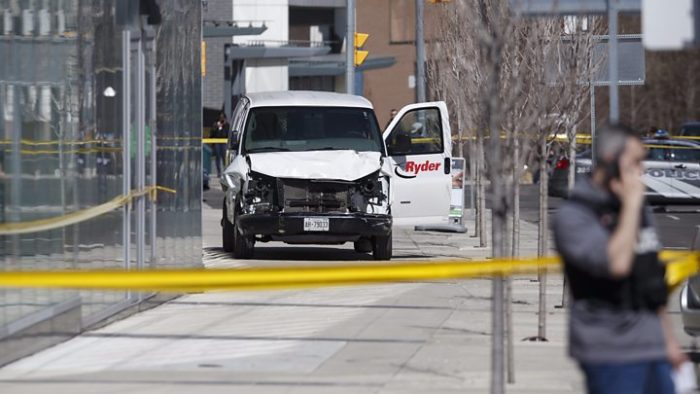

The calm actions of a police officer who arrested the Toronto van suspect without firing a shot have prompted praise and, in some quarters, astonishment.
Video from the scene shows suspect Alek Minassian pointing an object at the officer and shouting: “Kill me!”
The officer tells the man to “get down” and when the suspect says he has a gun, the officer repeats: “I don’t care. Get down.”
Minassian is then seen lying down and the officer arrests him.
Many in North America are asking how the suspect did not end up dead in a hail of police gunfire. It contrasts with incidents in the US where police have shot and killed unarmed people.
One US-based academic told the BBC that the officer would have had a “duty” to kill the suspect, if the object he was pointing was a gun.
Toronto Police Chief Mark Saunders told journalists the officer had done a “fantastic job” to understand the “circumstance and environment” and get to a “peaceful resolution”.
He said police in the city were “taught to use as little force as possible in any given situation”.
Mike McCormack, president of the Toronto Police Association, told the Globe and Mail newspaper that the officer was a “hero” and could have justified opening fire.
“This officer looked at what was going on and determined he could handle it the way that he did,” he said. He said he had spoken to the officer, who had told him: “I just did my job. What I did was no big deal. But look at these poor people.”
Media playback is unsupported on your device
Canada’s Public Safety Minister Ralph Goodale praised the “brave and professional” police response.
Some on social media have praised the officer’s “restraint” – while others such as author Viet Thanh Nguyen highlighted the apparent contrast with the behaviour of some US police.
However, Michael Lyman, professor of Criminal Justice Administration at Columbia College of Missouri, told the BBC that the officer may have had a “duty” to kill the suspect.
“Assuming the suspect is holding a gun and pointing it toward officers, it is concerning that the officer is not engaging the suspect with deadly force,” he said.
Professor Lyman said that the officer might not have opened fire out of fear of public criticism after the event.
“People died as a result of the suspect’s actions. Can we assume that the officer knew this? If so, this changes things a bit in that the level of public threat is higher. Under this circumstance, it would seem that the officer had a ‘duty’ to respond with deadly force – assuming what he was holding was a firearm,” he said.
Professor William Terrill from the Arizona State University School of Criminology & Criminal Justice said the officer may have judged that the object held by the suspect did not pose a threat.
“It’s possible the officer thought the object in the person’s hand was not a gun, or not a real gun. The fact that the officer left the cover of his car and exposed himself out in the open would further support such a supposition,” he said.
“It’s also possible the officer recognised a potential suicide-by-cop incident and chose not to engage with deadly force. The only remaining option I can posit is the officer simply froze.”
David Klinger, Professor of Criminology and Criminal Justice at the University of Missouri-St Louis said the video did not show enough detail for an informed assessment of the officer’s actions.
“If the cop could clearly see what was in the suspect’s hand, and that it wasn’t a gun, then it’s a simple matter of a cop doing his job correctly,” he said.
more recommended stories
 Fentanyl Seizures at Border Continue to Spike, Making San Diego a National Epicenter for Fentanyl Trafficking
Fentanyl Seizures at Border Continue to Spike, Making San Diego a National Epicenter for Fentanyl TraffickingFentanyl Seizures at Border Continue to.
 Utah Man Sentenced for Hate Crime Attack of Three Men
Utah Man Sentenced for Hate Crime Attack of Three MenTuesday, August 8, 2023 A.
 Green Energy Company Biden Hosted At White House Files For Bankruptcy
Green Energy Company Biden Hosted At White House Files For BankruptcyAug 7 (Reuters) – Electric-vehicle parts.
 Former ABC News Reporter Who “Debunked” Pizzagate Pleads Guilty of Possessing Child pδrn
Former ABC News Reporter Who “Debunked” Pizzagate Pleads Guilty of Possessing Child pδrnFriday, July 21, 2023 A former.
 Six Harvard Medical School and an Arkansas mortuary Charged With Trafficking In Stolen Human Remains
Six Harvard Medical School and an Arkansas mortuary Charged With Trafficking In Stolen Human RemainsSCRANTON – The United States.
 Over 300 People Facing Federal Charges For Crimes Committed During Nationwide Demonstrations
Over 300 People Facing Federal Charges For Crimes Committed During Nationwide DemonstrationsThe Department of Justice announced that.
